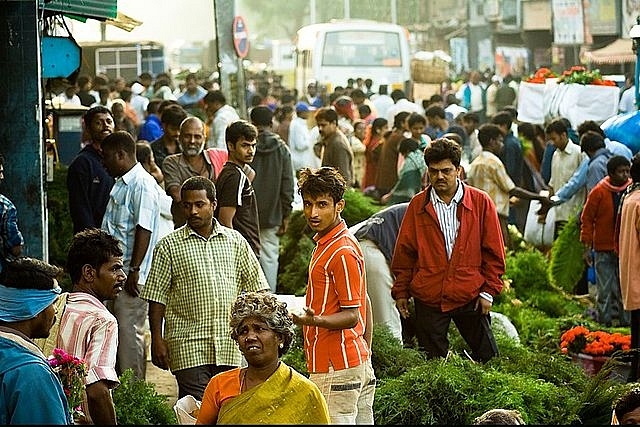Politics
Is The Middle Class Looking Beyond BJP?
- The Indian middle class is getting increasingly disenchanted with the BJP.
- If the party continues to ignore their concerns, they could make their voice heard on the ballot box, especially as their share in the electorate continues to rise.

(Akash Bhattacharya/Wikimedia Commons)
Petrol prices in many Indian cities today are higher than what they were when Prime Minister Narendra Modi took office on 26 May 2014. Globally, crude oil prices have softened from an average of $109 per barrel in 2013 to $44 per barrel in 2016. Prices have been rising for the past two years; however, they are still much below the levels seen in 2013. The middle class, which has been reeling under the impact of a slowdown in gross domestic product (GDP) and low salary hikes and bonuses, was expecting tax breaks in the Union budget 2018. However, left empty-handed, the petrol price hikes have left many of them aggrieved.
However, four years in power and Jaitley’s policies, where he adopted the approach of hiking excise duty in fuel products to meet fiscal deficit targets, have started turning the voters away from the party. The BJP suffered significant losses in the bypolls in Ajmer (approximately 84,000) and Alwar (approximately 2 lakh). It is important to note that in both these constituencies, the BJP won in 2014 by huge margins of 1.72 lakh and 2.84 lakh respectively. These two cities are among the top 10 urban centres of Rajasthan.
In Uttar Pradesh bypolls, the low voter turnout in Allahabad (25 per cent) was one of the primary reasons for the party’s loss in Phulpur. This points clearly to a sense of dissatisfaction among middle-class voters.
The cost of living has been rising over the years. The service tax rate, which was 12.36 per cent when the BJP came to power, has increased by almost 50 per cent, to 18 per cent. This has made our electricity, telephone, and internet bills expensive. No significant tax sops have been provided to the middle class. Petrol prices are at a four-year high despite crude oil prices declining globally. The senior citizens, who depend on interest income, are suffering because of a low-interest regime on account of demonetisation. The middle class has not received significant tax breaks, which could have otherwise acted as a balm. Standard deduction has been re-introduced, but the benefit has been taken back in the form of an increase in cess from 3 per cent to 4 per cent. While the government will lose Rs 8,000 crore due to standard deduction, it will gain Rs 11,000 crore from an increase in cess.
The BJP is trying to build a new vote bank of poor and lower-class voters in an attempt to not repeat Atal Behari Vajpayee’s mistake of ‘India Shining’. It’s often said that middle-class voters are not loyal. Even in the 2004 election, more middle-class voters supported the Congress than the BJP despite being the real beneficiaries of the ‘India Shining’ campaign. However, this strategy is fraught with risks.
- The number of poor and lower-class voters has been reducing over the years, from 74 per cent of the population in 2009 to 53 per cent in 2014.
- Middle and upper-class voters also vote in large numbers nowadays. The poor class recorded the lowest turnout in 2014 at 60 per cent, lower class 68 per cent, middle class 69 per cent, and upper class 67 per cent.
- “The middle class which tends to decide who governs, has an incentive to ally with the poor to exploit the rich. It also has an incentive to support the rich to avoid being exploited by the poor.” As per Iversen and Soskice, in a majoritarian electoral system, of which the Indian first-past-the-post is one, the latter motive dominates.
So, as the share of middle-class voters grows, no government can ignore their concerns. The Congress party paid a heavy price for this in 2014. The BJP cannot risk alienating this segment of voters and should not ignore their disenchantment. Otherwise, middle-class voters could align with the rich to negate the appeasement strategy directed currently to the poor and the lower class by the BJP.
Introducing ElectionsHQ + 50 Ground Reports Project
The 2024 elections might seem easy to guess, but there are some important questions that shouldn't be missed.
Do freebies still sway voters? Do people prioritise infrastructure when voting? How will Punjab vote?
The answers to these questions provide great insights into where we, as a country, are headed in the years to come.
Swarajya is starting a project with an aim to do 50 solid ground stories and a smart commentary service on WhatsApp, a one-of-a-kind. We'd love your support during this election season.
Click below to contribute.
Latest